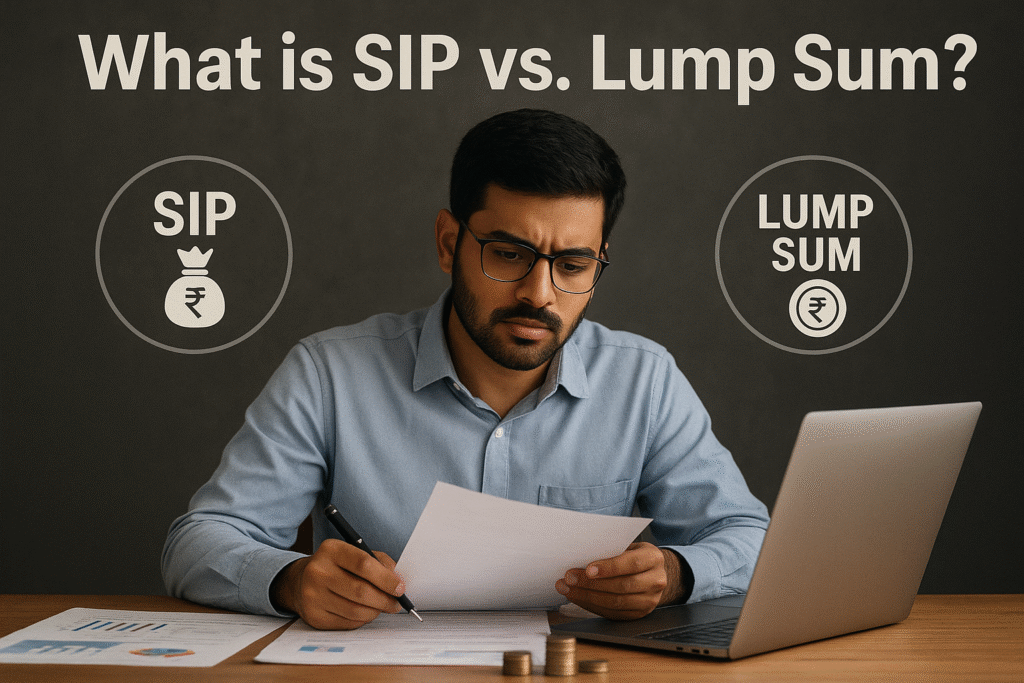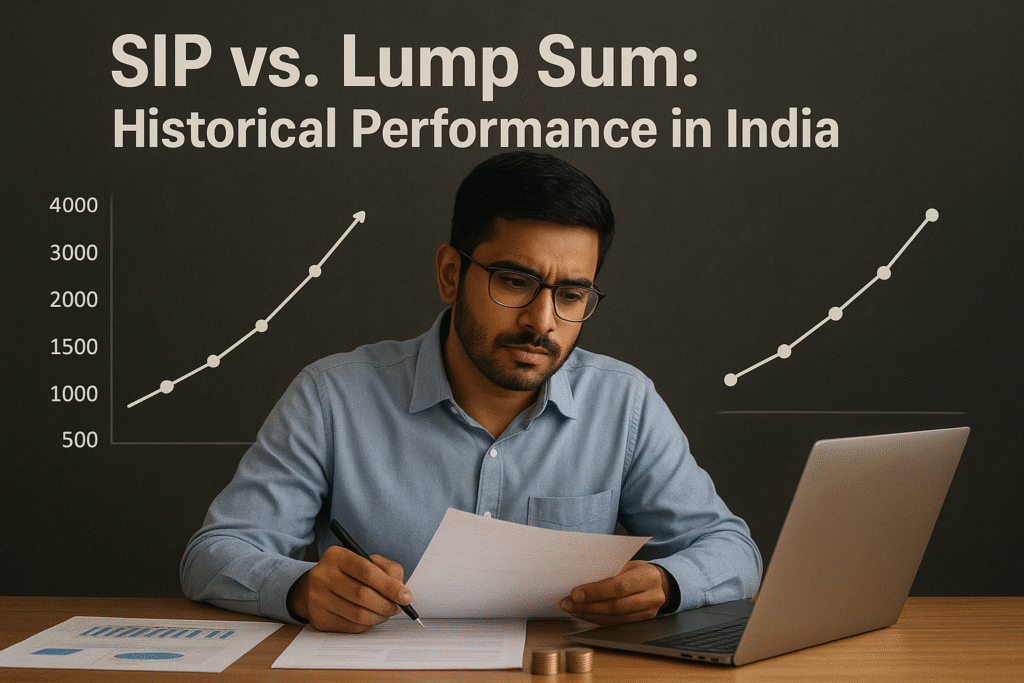Investing in mutual funds? One of the biggest dilemmas investors face is whether to use a Systematic Investment Plan (SIP) or invest a Lump Sum amount. Both strategies have pros and cons, and the best choice depends on market conditions, financial goals, and risk tolerance.
In this guide, we’ll break down:
✔ What SIP & Lump Sum investing mean
✔ When to use each strategy
✔ Real-world performance in India’s market
✔ Which is better for you?
1. What is SIP vs. Lump Sum?

A. SIP (Systematic Investment Plan)
What is SIP Investing?
Think of SIP (Systematic Investment Plan) as your personal wealth-building autopilot. Instead of stressing over market timing, you set up automatic monthly investments (say ₹5,000) into your chosen mutual fund. It’s like that recurring FD your grandparents loved – but with supercharged growth potential since your money works in the stock market.
Real-Life Magic:
Imagine committing ₹10,000 every month to a Nifty 50 index fund. Over a decade, you’re not just saving – you’re harnessing India’s economic growth through disciplined investing, regardless of market ups and downs.
Why It Works:
No need for huge capital to start
Removes emotional investing mistakes
Turns market volatility into your ally through rupee-cost averaging
The beauty? You can start smaller than your monthly pizza budget and scale up as your income grows.
✅ Best for:
Salaried individuals (disciplined investing).
Volatile markets (averages purchase cost).
B. Lump Sum Investing
Picture this: You’ve just received a windfall – maybe your annual bonus, an inheritance, or savings you’ve carefully set aside. Instead of letting it sit idle, you put the entire amount (say ₹1 lakh) to work in mutual funds all at once. This is lump sum investing – going all in when you believe the market is ripe for growth.
Real-World Scenario:
That ₹5 lakh from your property sale? Investing it as a single transaction in a flexi-cap fund could mean:
Catching an upward market swing for maximum gains
Eliminating the stress of timing future investments
Potentially higher returns if you invest during market lows
The Strategic Edge:
While it requires more market awareness than SIP, lump sum investing lets you fully capitalize on:
✅ Undervalued market phases
✅ Long-term compounding from day one
✅ Opportunities when you have significant idle cash
But Remember:
It’s like planting a money tree with one big seed – you want to choose the right season (market conditions) for best results.
✅ Best for:
Investors with surplus cash.
Falling or undervalued markets (buy low).
2. SIP vs. Lump Sum: Historical Performance in India

| Scenario | SIP Returns | Lump Sum Returns |
|---|---|---|
| Bull Market (2020-2023) | ~18% CAGR | ~25% CAGR |
| Bear Market (2018-2019) | ~10% CAGR | ~5% CAGR |
| Sideways Market (2024) | ~12% CAGR | ~8% CAGR |
📌 Key Insight:
SIPs outperform in volatile/falling markets (cost averaging).
Lump Sum wins in rising markets (full exposure to gains).
3. When Should You Choose SIP?

Just starting your investment journey? SIPs are like training wheels for the stock market – they remove the pressure of trying to time your entry perfectly. Instead of worrying about buying at the “right” moment, you automatically spread your investments across market highs and lows.
Here’s why smart investors love SIPs when:
💰 You’re taking your first steps
No need to be a market expert. Set up automatic investments and let time work its magic while you learn.
📈 Markets seem expensive
When indices are hitting record highs (like Nifty at 25,000), SIPs help you avoid dumping all your money at potentially peak prices.
💼 You’re building wealth paycheck to paycheck
That steady monthly salary becomes your investing advantage. Allocate 10-20% automatically before you’re tempted to spend it.
Pro Tip: Think of SIPs like planting seeds every month – some will grow during sunny markets, others during rainy downturns, but your garden (portfolio) keeps expanding regardless of weather.
Real Example:
If you started a ₹10,000/month SIP in Nifty 50 in Jan 2020, your investment would have grown 2.5x by 2025 despite COVID crashes.
4. When Should You Choose Lump Sum?

That sudden windfall – maybe your annual bonus just landed, or you’ve sold an old property – is actually a golden investment opportunity waiting to be seized. Lump sum investing turns your big-ticket money into immediate market participation, and here’s when it works best:
🎯 You’re sitting on idle cash
Whether it’s ₹5 lakhs from an inheritance or ₹2 lakhs from your ESOPs, lump sum investing puts your full amount to work from day one – no gradual dribbling into the markets.
📉 Markets are having a sale
When the Sensex dips 10-15% from its peak (like during corrections), it’s like finding your favorite stocks at a discount. Your entire investment benefits from buying at these lower levels.
⏳ You’re playing the long game
With 5+ years ahead, short-term volatility becomes background noise. Your money gets maximum time to compound – that ₹10 lakh invested today could grow exponentially by 2030.
Think of it like this:
Lump sum investing is planting a fully-grown money tree rather than seeds. You need the right soil conditions (market timing) and patience for it to flourish, but the growth potential is tremendous.
Pro Tip: Combine strategies – invest 60% as lump sum during corrections and SIP the remaining 40% to balance risk.
Real Example:
A ₹5 lakh Lump Sum in Feb 2020 (pre-COVID crash) would still be up ~100% in 2025 despite the initial drop.
5. Hybrid Strategy: Best of Both Worlds
Many experts recommend a mix of both:
Use Lump Sum when markets correct (e.g., 10-15% dip).
Continue SIPs for disciplined investing.
6. Verdict: Which is Better?
| Factor | SIP Wins | Lump Sum Wins |
|---|---|---|
| Market Timing | ❌ No need | ✅ Crucial |
| Risk Management | ✅ High | ❌ Moderate |
| Returns in Bull Run | ❌ Lower | ✅ Higher |
For most investors in India:
SIP is safer (volatile markets, emotional discipline).
Lump Sum is opportunistic (requires market insight).
Final Advice
Start a SIP if you’re new or uncertain.
Use Lump Sum only if you have idle cash + market knowledge.
🚀 Pro Tip: Use tools like ET Money’s SIP vs Lump Sum Calculator to simulate returns.




